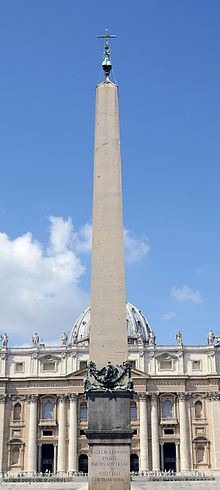Vatican obelisk

The Vatican Obelisk is an Egyptian obelisk in St. Peter's Square in front of St. Peter's Basilica in Rome . The 25 m high obelisk is blank.
description
Pliny mentions an unlabeled obelisk belonging to Pharaoh Nectanebos II. Since the obelisk in St. Peter's Square is the only one without an inscription, it has been assumed that it is this obelisk. However, this can be ruled out, since the obelisk mentioned by Pliny is said to have stood in Alexandria at the time .
The obelisk was erected in Alexandria by Gaius Cornelius Gallus , the first Roman prefect of Egypt under Augustus , as shown by an inscription that was deleted after the fall of Gallus but has to be reconstructed. Pliny reports that Caligula had the obelisk brought to Rome on a specially constructed ship and placed it on the spina of the Circus Gai et Neronis . This circus was located on the site of today's St. Peter's Basilica and was partially overbuilt by this or the previous Constantinian building. It is the only ancient obelisk in Rome that was not overturned.
The obelisk was associated with the martyrdom of Peter very early on and was therefore called "Pyramis Beati Petri". According to another tradition, a golden urn with the ashes of Gaius Iulius Caesar is said to have been in the bronze ball on the top .
The ancient dedicatory inscription reads:
| DIVO CAESARI DIVI IULII F AUGUSTO | The deified Caesar Augustus , son of Divus Iulius (the deified Gaius Iulius Caesar ) |
| TI CAESARI DIVI AUGUSTI F AUGUSTO | (and) Tiberius Caesar Augustus, son of the deified Augustus, |
| SACRUM | consecrated. |
In 1586 under Pope Sixtus V , it was installed at its current location by Domenico Fontana , who himself reports on this achievement in his book Della transportatione dell 'obelisco Vaticano e delle fabriche di Sisto V (Rome, 1590). It is thus the first obelisk that was erected in Rome in modern times. Fontana first had to put down the obelisk, then transport it to its new location and erect it there again. With a weight of over 300 tons, 150 horses, 900 men and 47 winches were required. Fontana himself put his signature under the dedicatory inscription of the Pope: Dominicus Fontana ex pago Mili agri Novocomenis transtulit et erexit . "Domenico Fontana from the Pagus Melide in the area of New Como - brought this obelisk here and erected it."
A separate congregation dealt with the location of the obelisk . At that time, St. Peter's Square still had its medieval appearance, so that neither the colonnades of Gian Lorenzo Bernini nor the facade of Carlo Maderno could be used as a guide. However, an alignment along the longitudinal axis of the church would have been possible. After a model had been erected on August 24, 1586, the obelisk was finally erected 3.8 meters north of the longitudinal axis.
See also
literature
- Géza Alföldy : The Obelisk on St. Peter's Square in Rome. A historical monument of antiquity . Winter, Heidelberg 1990, ISBN 3-533-04283-9 ( session reports of the Heidelberg Academy of Sciences, Philosophical-Historical Class , 1990, 2).
- Klaus Bartels: Rome's speaking stones. 2nd edition, von Zabern, Mainz 2001, ISBN 3-8053-2690-4 .
- Ernst Batta: Obelisks. Egyptian obelisks and their history in Rome. Insel, Frankfurt a. M. 1986, ISBN 3-458-32465-8 (Insel-Taschenbuch, 765).
- Cesare D'Onofrio: Gli obelischi di Roma. Rome 1967
- Domenico Fontana: Della trasportatione dell'obelisco vaticano et delle fabriche di nostro signore papa Sisto V. Domenico Basa, Rome 1590, ( online ).
- Richard Hillinger, Christian E. Loeben: Obelisks. Heliopolis, Luxor, Cairo, Byblos, Rome, Benevento, Istanbul, Urbino, Florence, Kingston Lacy, Munich, Paris, Durham, London, New York, Berlin. Exhibition in the Italian hall of the Landshut city residence from May 23 to June 2, 1992. Stadt Landshut, Landshut 1992, ISBN 3-927612-06-5 .
- Eckart Peterich : Rome. 2nd edition, Prestel, Munich 1998, ISBN 3-7913-2043-2 .
- Samuel Ball Platner, Thomas Ashby: A Topographical Dictionary of Ancient Rome. Oxford University Press, London 1929, pp. 366-371 ( online ).
- Reinhard Raffalt : Concerto Romano. Prestel, Munich 1955; 14th edition 1999, ISBN 3-7913-2236-2 .
- Peter Stephan: "Ecce signum crucis". The relocation of the Vatican Obelisk as an exorcism , in: D. Dittmeyer-Hössl, J. Hommers, S. Windmüller (eds.), Crazy, Slipped, Versetzt. On the displacement of objects, bodies and places (= series of publications by Isa Lohmann-Siems Foundation 8), Berlin, 2015, pp. 248–274
Web links
- The Roman Obelisks ( Memento from September 19, 2008 in the Internet Archive )
- Obelisco Vaticano (Italian)
Individual evidence
- ↑ Pliny: Naturalis historia 36, 67.
- ↑ AE 1964, 255 : Iussu Imp (eratoris) Caesaris Divi f (ili) / C (aius) Cornelius Cn (aei) f (ilius) Gallus / praef (ectus) fabr (um) Caesaris Divi f (ili) / forum Iulium fecit .
- ↑ Pliny: Naturalis historia 36, 69-70.
- ↑ CIL 6, 882 = CIL 6, 31191 .
Coordinates: 41 ° 54'8.1 " N , 12 ° 27'26.1" E.


